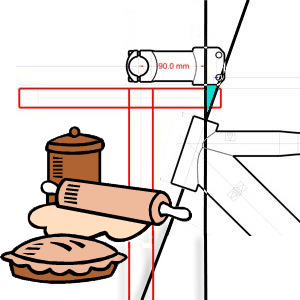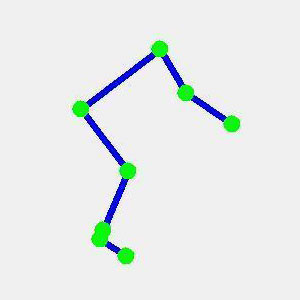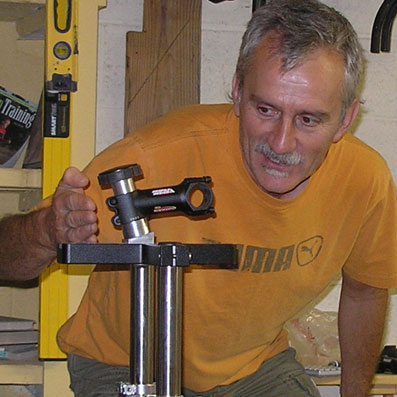Systems, tools and apple pie

Let's talk about fit systems. A "system" generates an output that the rider uses to help him select a bike, and to position himself aboard it. A fit system is like a cooking recipe. That recipe is not specific to a tool in the kitchen. It might in fact be very hard to follow this recipe without certain tools. For example, it's hard to add a half cup of sugar if you don't have a measuring cup. Nevertheless, the recipe, or the system (not the tool), generates the output.
Recipe: the output might be a tasty apple pie. Fit system: the output is you, on the right sized bike, positioned properly.
So, let me ask you: Have you ever had a "measuring cup apple pie?" You know, an apple pie made using the "Measuring Cup System?" How you do it is this: You give somebody a measuring cup, and the ingredients, and with that measuring cup he makes the apple pie.
Of course it's not as simple as that. You have to teach him how to use a measuring cup; how to fill it, and read the gradations on the side; and to know that when it's "this" full with sugar you've actually got a half-cup.
But that's still not enough, is it? There's an art and a science to pie making, and the art is having baked pies often enough to know instinctively what's going to make a really tasty pie; and the science is knowing not just how to measure the ingredients, but the correct amounts of those ingredients joined in proper proportions at specific points during the process of apple pie making.
So, when I read on our forum that someone has just had a "Retul fit," or an "Exit bike fitting" (both of which I recently read), I'm reading a post by someone who doesn't properly distinguish between a tool and a system. I'm reading about the cycling version of the "measuring cup apple pie." Retul is a tool. It is a very fancy measuring cup. An Exit fit bike is a tool. It is the very fancy pie tin in which the apple pie was baked.

Now, don't get me wrong. I have a Retul (pictured adjacent) in my fit studio and it's generating wonderful metrics for me — metrics I cannot generate without a "motion capture" tool. I have three Exit Cycling fit bikes, and they are in my estimate the best fit simulators made, if it's a tri bike fit you're interested in. If a fit studio has these tools, this is a serious studio, and there's a serious fitter in it. Still, these are tools, not systems.
But let's talk about the tools for a minute, because both of these tools — the Exit Cycling fit bike and the Retul — represent something new and different to a lot of bike fitters.
STATIC VERSUS DYNAMIC FITTING
In 1994 or thereabouts, a new way to measure bicycle seat height debuted. It was called the "Holmes Pruitt method" after its authors, one of whom is the famous Andy Pruitt of the Boulder Center for Sports Medicine. Formerly, seat heights were measured using a "static" value: either "trochanter height" or, using the "Lemond method," a fraction (.883) of your inseam.
By "static" we mean your seat height is determined by the length of a lever or set of levers, and this length is independent of your pedaling motion. A static measure could be applied to anyone, without any consideration given to how he or she rides his or her bike. At the risk of sounding macabre, I can go down to the morgue and calculate the proper saddle heights of each of these "subjects" if I'm employing a static measure of seat height.
The Holmes Pruitt method required you to ride your bike during the seat height calculation. What is your pedaling style? Are you a toe pointer like Marco Pantani or Jacques Anquetil? Or are you a heel dropper like Greg Lemond? If you care about this question, you can't use a static method of measuring seat height.
The Holmes Pruitt method makes the following assumption: Your knee angle at the bottom of the pedal stroke is what is important, and we can't know this unless we measure your knee angle at this point. For this reason, unless you're mounted on a trainer, riding a bike, we can't measure this angle, and we won't know your seat height.

So what we have here is a method. We have a recipe. It's the Holmes Pruitt recipe for baking apple pie… er… for measuring bicycle seat height. This method requires specific tools. It requires a bike, for example, and a stationary trainer. And it requires a way to measure the knee angle. The tool most commonly used for this is called a goniometer. But it is not the "goniometer" method of measuring seat height. It is the Holmes Pruitt method, and requires a tool called a goniometer (pictured adjacent is the popular bike fitter's Gollehon Goniometer).
Now, here's the interesting part. Even though the Holmes Pruitt method is a dynamic method of determining seat height (it's your seat height as measured by you pedaling a bike, not by measuring you just standing there), it used a static tool. Yes, you rode your bike on a trainer, forming this anticipated knee angle at bottom dead center (BDC) once every revolution. But the practitioner had to stop your pedaling at BDC to measure your knee angle with a goniometer. A Retul device is a dynamic tool. It measures your knee angle (and a lot of other angles) while you're riding, without any requirement that you stop.
The Retul "motion capture" system is often called a "system" not because of a step by step protocol for divining proper bike fit, but because this "tool" has a lot of parts, and there is a "system" for using this tool, just as there is a "system" for using a torque wrench. Nevertheless, its function is simply to measure. When you use it to measure the knee angle when discovering seat height according to the Holmes Pruitt method, you're using a dynamic tool in concert with a dynamic method. This is the acme in bike fitting. This is the state of the art. Why? Because the Holmes Pruitt method is technically correct and precise, but whenever you stop an athlete's pedaling to measure his knee angle, there is always the question: What "noise" does this create in the numbers? What is the difference in a static knee angle aboard a bike at BDC versus his knee angle measured on the bike, while riding, without the need to stop pedaling?
INSTANT FEEDBACK TOOLS
Let's take this one step further. What about making dynamic changes to a rider's position during a fit session? Let's consider fit bikes. There are good, better and best practices when it comes to changing rider positions during a fit session. The differences are in the tools. If you assume (and I do) that a rider's own sense of what is comfortable and powerful is important, then you've got to give him options from which to choose: "Is this better? Or is this better?" (Much like during an optometric exam.) Of course, you can't do this if you have no facility for presenting these differences.
One way to do this is to sit a rider aboard a bike, with the bike aboard a stationary trainer, and to have a rider lay himself out in the aero position and pedal the bike and get a "sense" of how he feels about this position. Then the fitter has the rider dismount the bike, or sit up, while the fitter takes the stem off the bike and replaces it with a stem 1cm longer. Then the rider pedals again, and says yes, that's better or, no, it's worse.
Or maybe he'll say, "I can't tell the difference." As you can imagine, this happens a lot when there are several minutes in between trials. So, the "fit bike" or "position simulator" was developed, to take this feedback time down from minutes to seconds.

There is now coming into the marketplace a third option, which is a way to make this change while a rider is still pedaling the bike. A rider can, without stopping his pedaling action, preview a seat height of 72cm versus 72.5cm, or an armrest elevation drop of 14cm versus 14.5cm. This sort of instant feedback allows a fitter to experience minute changes instantaneously.
So, "good" is a bike on a trainer with a lot of different stems and spacers and such. "Better" is a fit bike with parameters that can be changed in a fraction of the time, with gradations and measures on the fit bike that correspond to the metrics needed to determine bike geometries. "Best" is a bike that can be adjusted while the rider is aboard and pedaling, again with necessary metrics output by the fit bike itself.
In my fit studio are bikes that measure and adjust in a truly dynamic, "in situ" fashion, along with a motion capture system (Retul is the one I use, but is not the only one out there) to measure the body's angles during pedaling.
Obviously, just as the ability of the athlete trumps the "tools" he uses during a race (his wetsuit, bike, wheels, aerobars), a fitter's ability trumps his tools. A bike fit session might cost $300. Would you take your wife or husband to a $300 dinner just because you found out the chef had a dynamic measuring cup? Would you pop $300 for a Dynocup dinner? I think we all agree the ability of the chef using the Dynocup is an important part of the calculus.
But are you likely to order a designer pizza from a restaurant that does not have a pizza oven? How good is your pizza going to be if it's heated in a microwave? Accordingly — and I'm speaking frankly here — if you're going in for bike fit and it's executed on your own bike, or on a bike sitting on the floor, instead of on a proper fit bike, you're not getting a bike fit. You're getting a pizza heated in a microwave. You're getting the best position available to you on that one bike without the benefit of the instant feedback today's best simulators give you. Even a celebrated chef is not going to fix you a very tasty dinner if he chooses to do so without a proper kitchen, and tools, and ingredients.
And how good a chef is he really, if he tries to cook you a $300 dinner without investing in the proper kitchen and ingredients?
There is a way for you to know in advance what's in store for you (pun intended), before you book your tri bike fit session. We maintain a database of retailers who have various fit certifications and we keep track of the fit bikes and motion capture systems they have in their stores. Repair to the "advanced search" page of that database and you can find those dealers that have your desired mix of education and tools, and who are in your area.

One final note: Let me spend a brief moment exercising my bias (more than I have already). John Cobb, Michael Sylvester, Todd Carver (three examples of many) will not fit you the same way on your tri bike as they would on your road bike. When Sylvester teaches Trek dealers (in his Trek fit schools) about tri bike fit, it's a different fit — a different system — than the road fit system he teaches. Sylvester's approach is sound and rational.
Of course, these three fellows are more likely than not to give you a tri bike fit that we here would approve of (they've all been to our own tri bike fit workshop multiple times). The point is, they understand the differences between tri bike fit and road bike fit. (Note: one or more of these particular fitters may not have given you a tri-specific fit in times past that we'd endorse, but we're confident they're likely to give you a "Slowtwitch approved" fit today.)
These guys understand the difference between tri-specificity and road-specificity. You ought to be wary of those executing tri bike fits for you using a system that does not differentiate between tri and road positioning. I think it is up to Cyfac, Wobblenaut, Fit Kit, Serotta, Bikefitting.com, and others who offer excellent systems for determining road bike fit to explain how outputs for a tri bike differ from outputs for a road bike.
To be clear, I have no quarrel with any of these systems, as regards how metrics for a road bike position are generated. And, I have no trouble with someone relying on these metrics for use in racing triathlons — if it's a road race bike you intend to ride, with road race components, road handlebars, STI shifters, and in a road race position using road geometry. But if you intend to ride a Cervelo P3, or a Felt DA, or any tri-specific bike: this requires a different riding style and a different position. (This issue of "tri" versus "road" for use in triathlon is discussed here.)
The takeaway is to do your homework, and choose wisely. Understand the difference between a road bike fit system versus a tri bike fit system. The official Slowtwitch fit "system" is the one we developed (F.I.S.T.) and it is not applicable to road. Were we to claim it is applicable for road, this would not make it so; it would simply water down our claim that we know what we're talking about. Likewise, we would raise an eyebrow at anyone who claims his bike fit system generates one output equally applicable for road and tri.
My hope is that you better understand the difference between static and dynamic, and between a system and a tool. If you value the idea of a dynamic fitting, then you won't get it with a Retul system (other than simply for seat height) if a fit simulator is not used during the fit session. What you'll get is a dynamic measuring tool applied to a static (and slow-feedback) fit. Conversely, if your fit occurs on a fit bike, and your angles are measured with a goniometer, you've had a dynamic fit measured with a static measuring tool.
This isn't to say that static tools are never appropriate. If I was measuring a pro aboard a bike and aerobars he was contractually constrained to ride, perhaps an adjustable stem would do me, and I might execute that fit aboard his chosen bike, because my positioning options for this rider are limited anyway (but does this describe you?). Likewise, a goniometer is not a bad tool, and in the hands of a good practitioner it will measure certain angles well within the range of acceptability.
Furthermore, the tools aren't the final determiner of excellence. You ought to consider the theory to which the fitter ascribes, that is, his chosen "system." If your fitter uses a dynamic instant feedback fit bike, and a dynamic motion capture measuring device, but uses a flawed bike fit protocol, using the restaurant analogy your chef cooked your caesar salad in his very expensive pizza oven. How good is that "output?"
And, of course, your fitter has to be good. All the tools and the schools and systems and acronyms in the world won't guarantee excellence. When a fitter who doesn't understand and apply and practice what he's learned, well, your meal, though cooked in the expensive pizza oven, might as well have been prepared by the restaurant's hostess.






Start the discussion at forum.slowtwitch.com